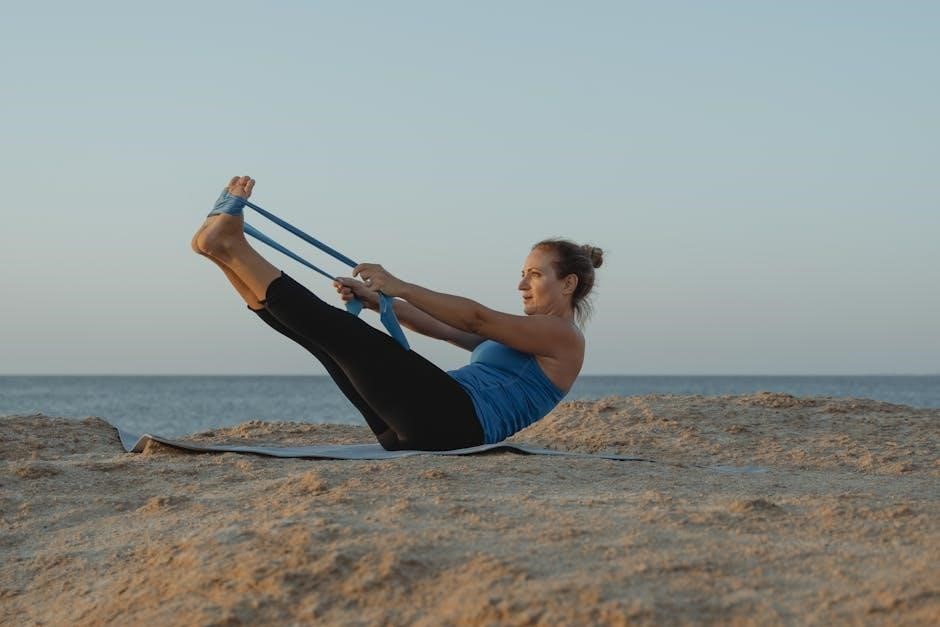Diastasis Recti Exercises

Effective exercises for diastasis recti focus on strengthening core muscles‚ such as transversus abdominis contractions‚ pelvic tilts‚ and bird-dog exercises; Consistency is key‚ with exercises performed daily to promote healing and improve abdominal strength. PDF guides offer structured workout plans.
Definition and Causes of Diastasis Recti
Diastasis recti‚ also known as abdominal muscle separation‚ occurs when the rectus abdominis muscles split along the linea alba‚ the connective tissue running down the abdomen. This separation can weaken core stability and lead to a visible bulge or “pooch.” Common causes include pregnancy‚ where hormonal changes and abdominal expansion stretch the linea alba‚ and postpartum strain from activities like heavy lifting or coughing. Obesity‚ genetics‚ and certain exercises that apply excessive pressure on the abdomen‚ such as crunches‚ can also contribute. While often associated with postpartum women‚ diastasis recti can affect anyone‚ including men‚ especially those with significant weight gain or repetitive straining. Symptoms often include lower back pain and a visible midline bulge‚ particularly when engaging in activities that increase intra-abdominal pressure‚ such as sneezing or lifting. Early identification and targeted exercises can help address the condition‚ but understanding its causes is crucial for effective management and prevention.
Symptoms and Diagnosis of Diastasis Recti
The primary symptom of diastasis recti is a visible bulge or “pooch” in the abdominal area‚ often more pronounced during activities like coughing‚ sneezing‚ or lifting. This separation of the abdominal muscles can also cause lower back pain and poor posture; In severe cases‚ the abdominal wall may protrude significantly‚ especially when engaging in exercises that increase intra-abdominal pressure‚ such as crunches or sit-ups. Diagnosis typically involves a physical examination by a healthcare provider or physical therapist‚ who may assess the degree of separation by palpating the abdominal muscles while the patient lifts their head or engages their core. Self-assessment is also possible by lying on your back‚ knees bent‚ and gently pressing fingers into the abdominal midline to feel for a gap or softness. The presence of a noticeable gap‚ often wider than one finger’s breadth‚ confirms the condition. Early detection is crucial for implementing appropriate exercises and treatments to address the separation and restore core strength. Regular monitoring and professional guidance can help manage symptoms effectively and prevent further complications.
Importance of Exercise in Diastasis Recti Treatment
Exercise is crucial for stabilizing the core‚ improving posture‚ and strengthening abdominal muscles. Gentle core-strengthening exercises can reduce the abdominal gap and improve overall core functionality‚ offering a non-surgical approach to managing diastasis recti effectively.
Safe Exercises for Diastasis Recti
Gentle‚ core-strengthening exercises are essential for managing diastasis recti. Transversus abdominis contractions‚ pelvic tilts‚ and bird-dog exercises are highly recommended. These movements stabilize the core without putting excessive strain on the abdominal wall. PDF guides often include detailed routines‚ such as daily exercises like drawing the belly button toward the spine and holding for 5-10 breaths. Lying on your back with knees bent and engaging the deep core muscles is another effective practice. Exercises should avoid any movements that cause the abdominal muscles to bulge‚ such as crunches or heavy lifting. Instead‚ focus on controlled‚ low-intensity activities that promote healing and strengthen the linea alba. Consistency is key‚ with exercises performed multiple times a day to gradually improve core strength and reduce the separation. Always consult a healthcare provider or physical therapist before starting any new exercise program to ensure safety and effectiveness.
Exercises to Avoid
Certain exercises can worsen diastasis recti by putting excessive strain on the abdominal wall. Avoid activities that cause the stomach to bulge‚ such as crunches‚ sit-ups‚ and heavy lifting. High-intensity workouts‚ planks‚ and traditional push-ups can also exacerbate the condition. PDF guides emphasize the importance of avoiding any exercise that creates intra-abdominal pressure‚ as this can further separate the abdominal muscles. Bending or twisting movements‚ especially without proper core engagement‚ should be avoided. Additionally‚ exercises that involve lying flat on the back and lifting the shoulders off the ground can strain the linea alba. It’s crucial to refrain from any movements that cause discomfort or visible bulging of the abdominal muscles. Instead‚ focus on gentle‚ core-strengthening exercises that promote healing without putting additional stress on the abdominal wall. Consulting a physical therapist or healthcare provider can help identify safe alternatives and ensure a proper exercise routine.
Role of Core Engagement in Healing
Core engagement is vital for healing diastasis recti‚ as it strengthens the transversus abdominis muscle‚ which stabilizes the spine and pelvis. Activating this muscle helps reduce the abdominal gap by improving intra-abdominal pressure. Without proper engagement‚ exercises may fail to target the correct muscles‚ potentially worsening the condition. PDF guides emphasize techniques like drawing the belly button toward the spine to engage the transversus abdominis effectively. Consistent core engagement improves posture‚ reduces back pain‚ and supports overall core stability. It also enhances the effectiveness of other exercises by providing a strong foundation for movement. Proper engagement ensures that the abdominal muscles work harmoniously‚ promoting healing and preventing further separation. Physical therapists often recommend exercises that focus on core activation to aid in the recovery process. By prioritizing core engagement‚ individuals can create a stable environment for their abdominal muscles to heal and strengthen‚ which is essential for long-term recovery from diastasis recti.

Creating a Workout Plan for Diastasis Recti
A structured workout plan for diastasis recti begins with core stabilization‚ progressing through phases. PDF guides offer daily routines‚ focusing on gentle exercises that strengthen abdominal muscles without causing strain. Plans are tailored to individual healing stages.

Daily Exercise Routine
A daily exercise routine for diastasis recti should focus on gentle‚ core-strengthening movements to promote healing without strain. Begin with transversus abdominis contractions: breathe out and draw your belly button toward your spine‚ holding for 5-10 seconds. Repeat 10-15 times. Incorporate pelvic tilts by lying on your back with knees bent‚ tilting your pelvis upward‚ and holding for 5 seconds. Perform 3 sets of 10 repetitions. Bird-dog exercises‚ done on hands and knees‚ extend one arm and the opposite leg‚ holding for 5 breaths on each side. Complete 3 sets; Gentle cat-cow stretches can also be added to improve spinal mobility. End with deep breathing exercises to engage the core and relax the muscles. Consistency is key; aim for 10-15 minutes daily. For advanced routines‚ incorporate modified planks or side bends‚ ensuring no bulging occurs. Always prioritize proper form and avoid pain. PDF guides provide detailed workout plans tailored to individual needs‚ ensuring a progressive approach to healing diastasis recti effectively.

Progressing Through Phases of Exercise
Exercise progression for diastasis recti is crucial to ensure safe and effective healing. The process is typically divided into three phases‚ each lasting four weeks. Phase One focuses on stabilizing the core and restoring abdominal strength through gentle bodyweight exercises like transversus abdominis contractions‚ pelvic tilts‚ and deep breathing. These exercises are performed daily to build a strong foundation without putting pressure on the abdominal wall. Phase Two introduces low-impact movements‚ such as modified planks and bird-dog exercises‚ to further strengthen the core while maintaining proper engagement; Finally‚ Phase Three incorporates dynamic exercises like gentle crunches or side bends‚ provided there is no bulging or discomfort. Progression should be gradual‚ with careful monitoring of symptoms like pain or abdominal separation. PDF guides often provide structured workout plans tailored to each phase‚ ensuring a safe transition and maximizing results. Consistency and patience are key‚ as healing diastasis recti requires time and careful attention to proper form and engagement.
Connection Between Exercise and Healing

Exercise plays a vital role in the healing process of diastasis recti‚ as it strengthens the core muscles and promotes the repair of the linea alba. Through targeted movements like transversus abdominis contractions and pelvic tilts‚ individuals can improve abdominal stability and reduce muscle separation. Consistency in performing these exercises‚ as outlined in PDF guides‚ is essential to achieve noticeable results. Studies suggest that regular engagement in core-strengthening activities can significantly enhance the healing of diastasis recti‚ particularly when combined with proper posture and body mechanics. Additionally‚ exercises that avoid excessive strain on the abdominal wall‚ such as gentle stretches and low-impact aerobics‚ contribute to a safer and more effective recovery. The connection between exercise and healing lies in the gradual rebuilding of muscle strength and connective tissue integrity‚ which supports long-term resolution of the condition. By adhering to structured workout plans and avoiding aggravating activities‚ individuals can promote optimal healing and restore core functionality.
